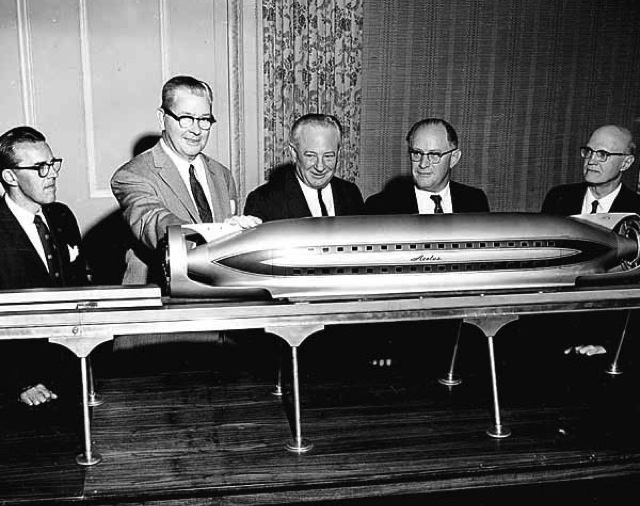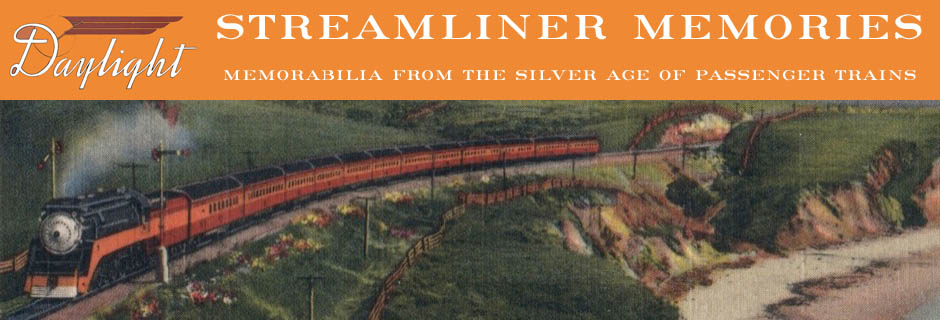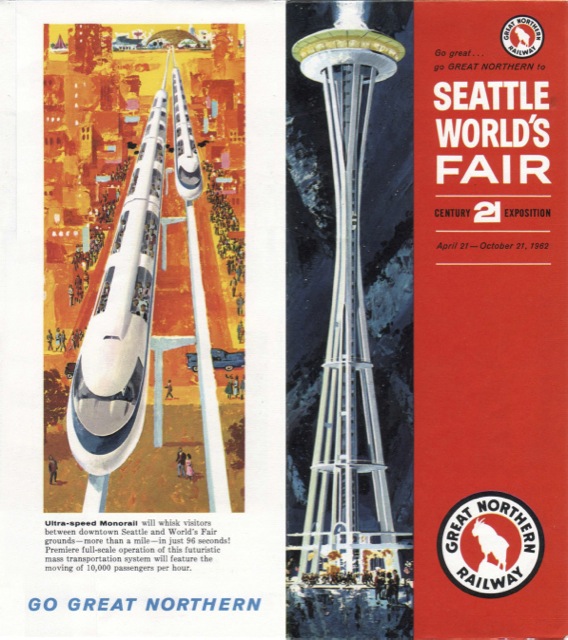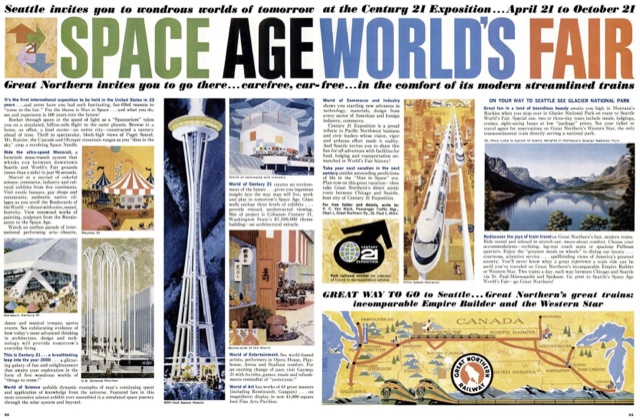The Seattle World’s Fair gave passenger service on the Great Northern, and presumably the Northern Pacific, a reprieve not granted to many other railroads. It didn’t hurt that the Milwaukee Road–afraid that its money-losing Olympian Hiawatha would actually make money in 1962 and thereby make it more difficult to gain approval to discontinue the train after that–abandoned passenger service in the Pacific Northwest in 1961.
Notice that the early vision of what the Seattle Monorail would look like was far from the final reality. Click to download a 3.3-MB PDF of this Great Northern brochure advertising the 1962 World’s Fair.
In the winter of 1959-1960, passenger demand on the Empire Builder had fallen so much that the railroad, for the first time, dropped the train’s observation car (which was mostly a sleeping car as it had only eight seats in the observation compartment). While the summer train had four coaches and five sleepers (including the observation car), the winter train had just three each plus, of course, the Ranch car, diner, and full-length dome.
However, for the summer of 1960 the railway was so confident of business that it added two flat-top coaches to the Empire Builder‘s consist, thereby making a total of six coaches and five sleepers (including the returned observation-sleeper). In addition, for the first time in history, the GN allowed tour cars on the Empire Builder for groups going from Chicago to Seattle. Tour cars going to Glacier stayed on the Western Star.
The Seattle World’s Fair prompted the Great Northern to place what may have been its only two-page magazine ads. This appeared in the March 16, 1962 issue of Life magazine as well as a roughly similarly dated issue of Saturday Evening Post. Click image to download a high-resolution PDF of this ad.
During the summer of 1962, GN added a sixth sleeper to the Empire Builder‘s regular consist and the train usually carried up to four more sleepers carrying tour groups to and from the fair. This added up to as many as 23 cars, which required five locomotives (instead of the usual four) to get over the Rocky Mountains.
Meanwhile, in May, 1961 the Great Northern had combined the Western Star with a train known as the Fast Mail. The latter train consisted mainly of baggage cars and–later–piggy-back trucks carrying less-than-first-class mail plus a coach for anyone whose schedule wasn’t compatible with the railroad’s main trains. As a combined train, the piggy-back trucks ran in back so the passenger cars could get steam heat from the locomotive, which meant the rear view from the Mountain-series observation car was partially obscured.

Railroad executives admire, or maybe laugh at, a model of the Ford “Levatrain” at the Seattle World’s Fair’s railroad exhibit, which was co-sponsored by GN, NP, UP, and Milwaukee railroads. The Levatrain was designed by a Ford engineer who thought hover cars were the wave of the future, but Ford gave up its experiments with hover cars because no one could figure out an efficient way to propel them.
For the summer seasons, the railroad operated the train in two sections a few minutes apart, thus preserving the Western Star‘s dignity as a passenger train. During the 1962 summer season, the Western Star regularly had five coaches and four sleepers; the usual non-revenue cars: diner, coffee shop-dorm, and Mountain-series observation car; and any tour cars from other railroads, including all tours headed to Glacier Park. Since many people decided to stop off in Glacier on their way to the fair, the number of people getting off the train at the park more than doubled from the summer of 1961.
The GN was doing so well that it purchased coaches from the Chicago & North Western, MKT, and other railroads that were discontinuing their passenger service. Early in the fair’s season, the GN’s passenger traffic manager noted that “the volume of Seattle World’s Fair traffic thus far has surpassed our expectations. Every piece of available equipment is in use including the North Western coaches purchased this year.”


